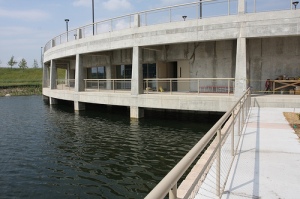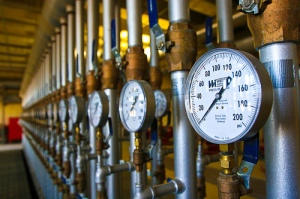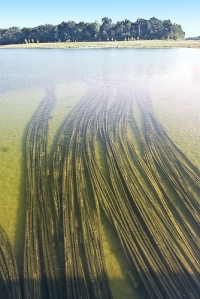Use QR Codes to Learn More about the Geothermal Lake
June 1, 2010
 The new Sherman Hospital’s cafe not only has a great selection of food, but also a great atmosphere to enjoy it in. At the cafe you’ll enjoy the natural light that comes in from the large windows that overlook the geothermal lake, and now that it’s getting warmer out you can even dine al fresco right next to the lake.
The new Sherman Hospital’s cafe not only has a great selection of food, but also a great atmosphere to enjoy it in. At the cafe you’ll enjoy the natural light that comes in from the large windows that overlook the geothermal lake, and now that it’s getting warmer out you can even dine al fresco right next to the lake.
Since we knew diners would spend a good deal of their meal looking out at the 15-acre lake, we thought we’d explain a few geothermal facts. And since geothermal technology is new to people, why not use an interesting new technology to help people learn more about it as they dine? So we have put QR Codes on table tents in the cafe.
What’s a QR Code, you might wonder? It’s a black and white image that works like a Bar Code with a smart phone. Using QR Code application, you can use your smartphone to take a picture of the QR Code, which will launch a web page in your smartphone’s browser. The QR Code on the Sherman cafe table tents takes you to a page that tells you more about the geothermal lake and how it works.
QR Codes are everywhere in Japan (on billboards, building signage, and even on fast food packaging), and they are a simple way to connect print with mobile technology. People scan QR Codes on building signage for a map of how to get somewhere within the building. They scan billboards for a link to coupons. They scan fast food packaging for nutrition information. QR Codes have just started showing up in the US recently, and use of them may spread as smartphones grow in popularity. For now, we decided to have fun with QR Codes to give our smartphone-using diners a new way to interact with the geothermal lake.
So if you have a smartphone, come by the Sherman cafe to check out how QR Codes work. Also, visit ShermanHealth.com from your smartphone to see our new mobile site, which lets you view hospital floorplans, send an ecard to a patient, find a physician, and more.
A Springtime Walk Around the Geothermal Lake
May 6, 2010
During Sherman’s Nurses Ceremony on the morning of May 5, the sun peeked through the clouds and illuminated the geothermal lake and the landscape beyond. After the ceremony concluded we took full advantage of the warm rays by walking the path that surrounds the lake. Here are 6 new photos of the walk.
You’ve heard that the new Sherman Hospital’s 15-acre lake not only provides beautiful views from the patient rooms, but it helps to heat and cool the entire hospital, saving $1 million in energy costs per year. And you know it’s a pretty big deal–it’s the largest geothermal system in Illinois and one of only 2 currently heating and cooling medical centers in the US. But you might not know the answer to the most basic question about the lake: How exactly does it work?
What is Geothermal Energy?
Geothermal energy is energy that is derived from the temperature of the earth. The earth absorbs 50 percent of all solar energy and traps it as heat just below the frost line. Using a heat pump, this natural and renewable resource trapped below the earth’s surface is transformed into a harnessable form of energy. This energy –geothermal energy– provides buildings with a dependable, eco-friendly and economic heating and cooling system.
The tools that make it happen:
- The temperature at the bottom of the lake—a constant 55 degree F in all climates. The ground absorbs almost 50% of the sun’s heat as it hits the earth’s surface. Regardless of the season, this solar energy maintains a relatively constant 55 degree temperature at the bottom of the lake, around 17-18 feet deep.
- A lake loop heat-pump system under the water, including 185 miles of pipes that are placed at the bottom of the lake to harness the energy. The pipes hold a heat-absorbing solution, and the heat pumps move heat from one place to another.
- A “manifold” building that houses over 170 pressure gauges connected to the pipes. This piping is channeled into supply and return pipes that are run to the building and fan out to individual heat pumps.
- Heat pump units housed just outside patient rooms that allow each room to be temperature controlled individually.
In the winter, the 55 degree temperature at the bottom of the lake is absorbed into a heat-absorbing fluid that constantly runs through the pipes. That heat is harnessed from the pipes through the pressure gauges, and pulled into the building. There it is concentrated and released into the building at a higher temperature. The heat is distributed through a conventional duct system as warm air. In the summer, the process is reversed–the heat from inside the hospital is pushed back down and stored in the cooler earth. Like in a refrigerator, cold air is not pushed into the hospital–rather, the heat is removed from the air.
Learn more about Sherman’s geothermal lake.
The New Geothermal Lake Page
October 6, 2009
One of the main features of the brand new Future of Sherman website is the dedicated page solely devoted to the geothermal lake. The lake will use geothermal energy to heat and cool the new hospital, which will save around $1 million per year in energy costs. It’s the largest geothermal system in Illinois and one of only two systems heating and cooling a medical center in the entire United States.
To check out the brand new page, either click on the image above or click here. The new hospital opens in just 70 days, so be sure to check out the new features before it opens!
Features of the New Hospital
September 17, 2009
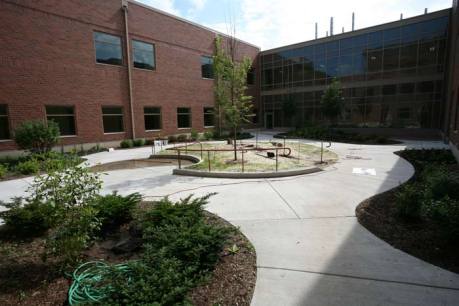
In less than 3 months, the new Sherman Hospital at Big Timber and Randall roads in Elgin will open. With 255 private patient rooms, everything about the new hospital was designed to make patients and their families as comfortable as possible—from the food to the views. With the opening date approaching quickly, we thought it’d be a good idea to recap some of the features of the new hospital.
Healing setting: The facility features beautiful views of a 15-acre, environmentally friendly lake and forest preserve, in addition to bright, open spaces inside the hospital.
Reduced ER waits: To reduce wait times and enhance patient comfort, the new emergency department will offer in room check-in.
Comprehensive cancer care: The new stand-alone Cancer Care Center will offer comprehensive treatment options, including radiation oncology.
Comfortable rooms: Each patient room includes a private bathroom with a shower. Most rooms will include sleeper couches for loved ones. Family lounges are located nearby, and visitors are welcome any time.
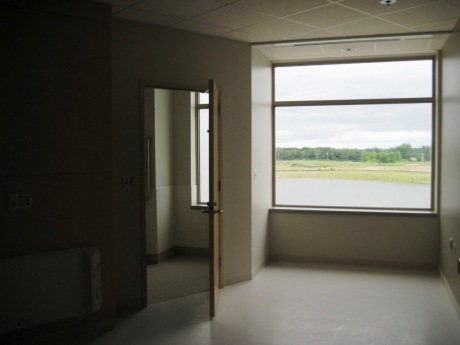
New food options: Drinks and healthy snacks will be offered for family members on each floor. For guests, food will be served at our new cafeteria, which is designed like a food court. You’ll find more choices, with food cooked to order, in a bright, airy atmosphere. Patio dining will be available when weather permits. For patients, we will offer room service from a restaurant–style menu featuring a variety of healthy meal options. Patients will be able to order meals at their own time, unless directed by a physician.
Green technology: A 15-acre geothermal lake will help heat and cool the hospital, saving more than $1 million a year in energy costs while promoting green initiatives in the community. The temperature at the lake’s bottom—a constant 55 degrees—will be the hospital’s heating and cooling source, with energy for the hospital harnessed by a loop-heat pump system under the water. Sherman’s geothermal lake is the only one of its kind in Illinois and one of only two lakes currently heating and cooling medical centers in the U.S. The lake also will feature a half-mile walking path.
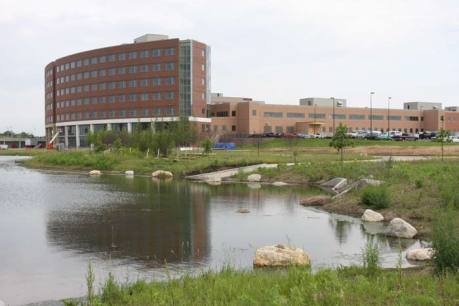
To learn more about these exciting changes and watch our construction progress, visit the Future of Sherman website.






